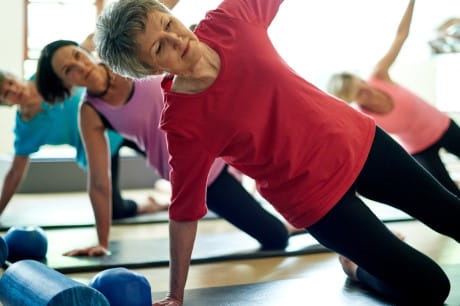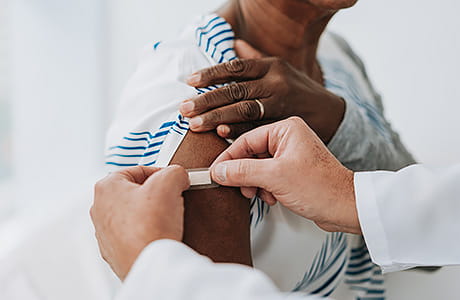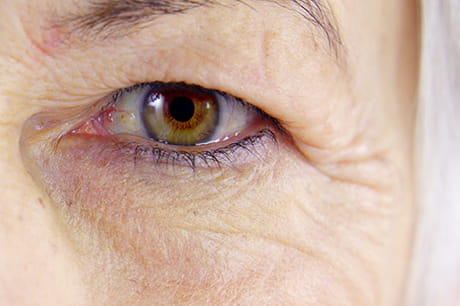4 easy-to-learn exercises for seniors
Exercise and nutrition are parts of a healthy lifestyle at any age and, as you get older, they can help you feel and look younger — and stay independent for longer, too.
Exercise makes you stronger, increases your energy and helps improve balance — which can prevent falls. It can also help with depression and prevent or delay serious medical issues like diabetes, osteoporosis and heart disease. And the good news: Even a little bit can make a big difference. Start low and go slow. Once you start to feel better, doing more will be as easy as it is fun.
Exercise for seniors: Where to begin
“Exercising helps you maintain your independence and quality of life,” says Theresa Craig, wellness coordinator for Geisinger 65 Forward Health Center in Scranton. “Any senior exercise routine should include a mix of cardio activities, strength training, balance and flexibility challenges. The exercises can be tailored to anyone’s individual fitness level. But talk to your doctor before starting a new routine, especially if you haven’t done a lot of physical activity recently.”
Good questions to ask your doctor:
- What types of exercise would be best for me?
- What activities should I avoid?
- Does my medical condition affect my ability to exercise?
Begin any exercise routine with five minutes of stretching or walking slowly to warm up. End your sessions the same way, with a five-minute cool-down.
1. Water aerobics
If you have access to a pool, water aerobics offer plenty of beneficial exercises for seniors — especially if you have arthritis or other joint pain. The buoyancy of the water puts less stress on your joints and offers natural resistance to help build strength with minimal stress on the body.
Try aqua jogging next time you’re in a pool. You may never switch back to land!
2. Chair yoga
Not ready for yoga on a floor mat? No problem. Many traditional poses have been adapted for sitting in a chair. In fact, it’s become one of the most popular forms of exercise for seniors. No matter how you approach it, yoga improves muscle strength, balance and flexibility. It can also help with anxiety and depression and leave you with a sense of calmness and well-being.
3. Working out with resistance bands
Resistance bands are elastic strips of rubber. Some are easy to stretch, and others are tougher, so you can choose the level that’s right for you. Give them a good steady pull and they’ll give your workout resistance without putting too much strain on your joints and muscles. They’re less expensive than most fitness equipment, so there’s less strain on your wallet, too.
4. Strength training with dumbbells
Light dumbbells are great accessories for senior exercise routines. Strength training helps you manage your weight because it leads to a higher metabolism rate. And dumbbells make it easy to do right in the comfort of your own home. You’ll not only burn calories faster, but you’ll improve your balance and flexibility, too.
A few simple movements, like bicep curls, will help prevent muscle loss and build bone density.
Eat right to fuel your workout
A balanced diet that includes protein, healthy fats, carbohydrates and plenty of fiber helps keep your body strong and ready to take on a new exercise routine. It also helps you manage your weight and can prevent diabetes, heart disease and other medical issues.
Make sure your diet includes:
- Five servings of fruits or vegetable a day. They’re full of fiber, which is great for digestion.
- Beans, fish and lean meats. They’re good sources of protein for building muscle.
- Whole grain bread, cereal and pasta.
- Calcium from milk, cheese and yogurt. Keeping your bones strong as you age will prevent injury while exercising.
- Plenty of water every day. Staying hydrated is key for every part of your body — especially when you’re getting a lot of exercise.
Signs that you might have overdone it
“While you may feel muscle soreness for a day or two after you exercise, you should not feel any sharp tightness, pain, throbbing or burning from exercise,” says Ms. Craig. “If you do, stop exercising and consult your doctor before resuming any activity.”
Tell your doctor immediately if you notice any of these issues while exercising:
- Chest pain or pressure
- Trouble breathing
- Lightheadedness or dizziness
- Balance problems
- Nausea
Next steps:
Learn how Geisinger makes better health easier
Learn more about Geisinger 65 Forward
5 benefits of walking every day





